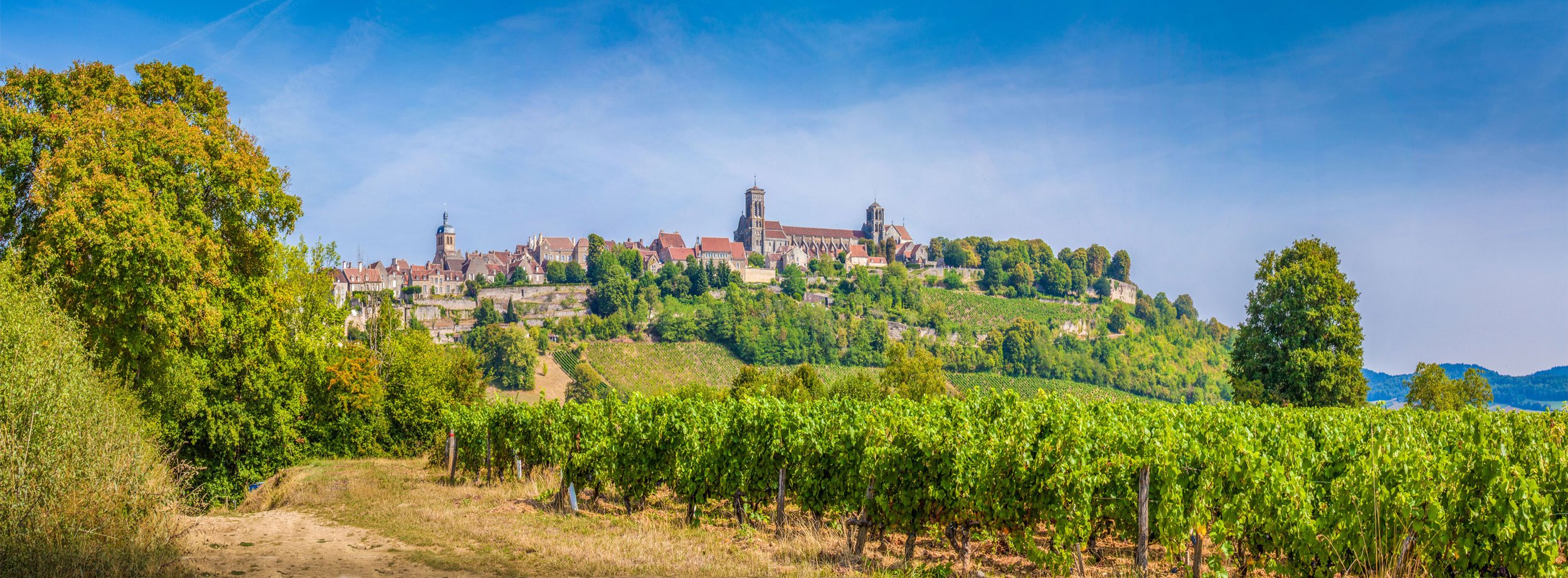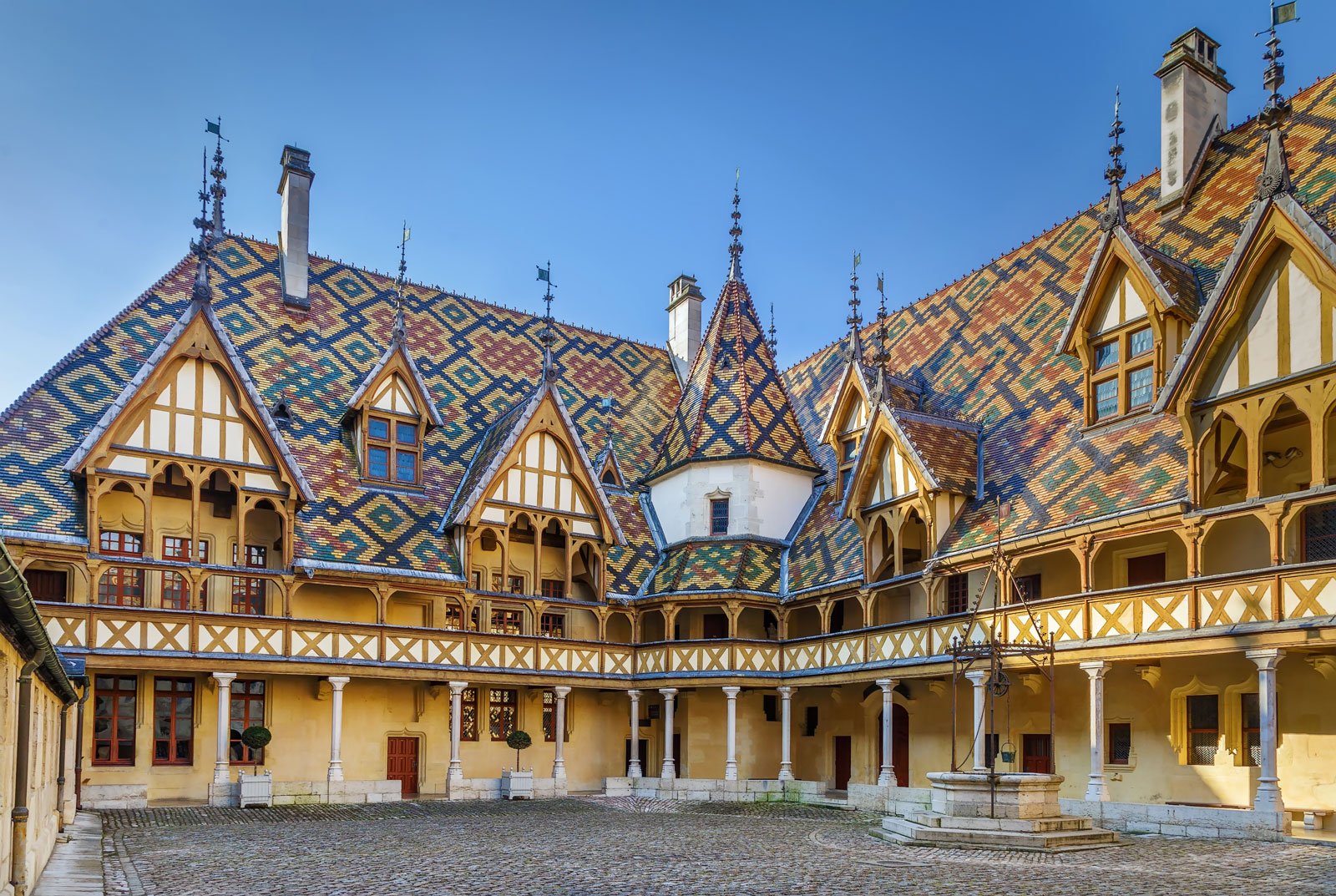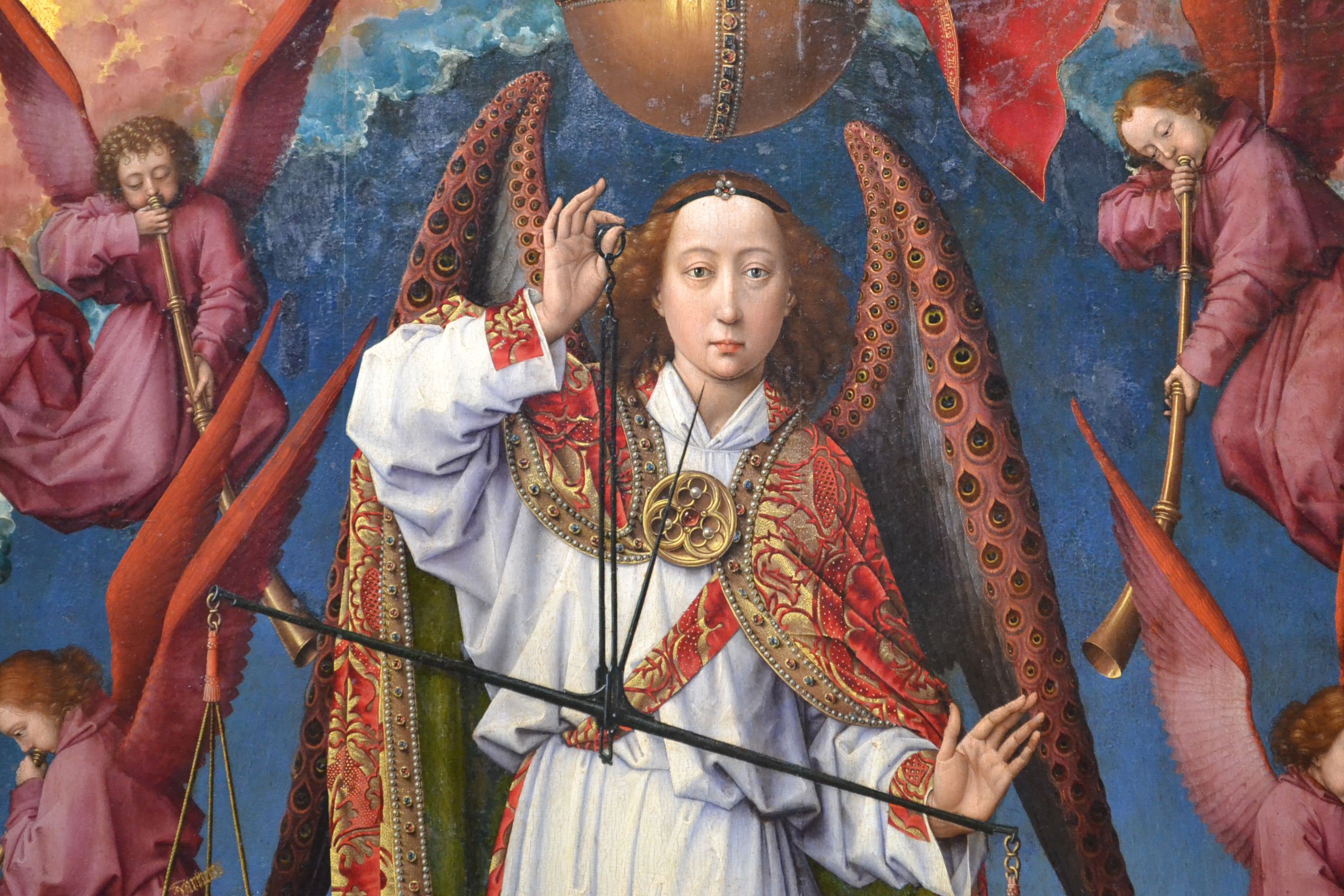
Exploring Medieval Burgundy
9-18 May 2024
Dr Kathleen Olive
Explore Burgundy’s cultural heritage, from outstanding medieval art and architecture to prestigious food and wine, complemented by a program of scenic walks in historic districts
OVERVIEW
Burgundy is an extraordinarily rich cultural destination. In the Middle Ages it was a powerful centre of Christendom and, as the capital of the Dukes of Burgundy, set European tastes in luxury arts, such as manuscript illumination, painting, sculpture and fashion. More recently, Burgundy has become one of the world’s most prestigious small wine districts, its vineyards part of its unspoiled landscape.
This 9-day tour takes an in-depth look at the heritage of Burgundy, venturing out from a comfortable base in the pretty town of Beaune. Through a carefully-designed program of talks and excursions, we explore superlative Romanesque and Gothic art and architecture in Cluny, Autun, Vézelay and Fontenay. A complementary program of gentle walks takes us through picturesque villages and vineyards, to fine Renaissance châteaux and gardens, and alongside the Burgundy Canal.
The touring program is complemented by select gastronomic experiences, showcasing the best of Burgundy, and by the expertise of your tour leader, art educator Dr Kathleen Olive.
TOUR LEADER
Dr Kathleen Olive is one of Australia’s best-known cultural tour leaders, with over fifteen years’ experience leading tours to Europe, North America, Australasia and Japan.
Kathleen is particularly known for her expertise in Renaissance studies and holds a PhD in Italian Studies from the University of Sydney. She lived and studied in Italy for a number of years and speaks fluent Italian, in addition to being conversant in French and Spanish.
Kathleen has regularly presented on Western European art, history and culture, at the WEA, Sydney, the Art Gallery of NSW, The Johnston Collection (Melbourne) and for the Australian Decorative and Fine Arts Society (ADFAS). She has designed and led over 70 successful tours, including a previous popular tour encompassing Burgundy. Kathleen is known for her engaging and attentive group leadership.
Details
DATES:
9-18 May 2024
ITINERARY:
Beaune (9 nights)
PRICE:
$7,990pp twinshare
SINGLE SUPPLEMENT:
$1,640 for sole use of a double room
DEPOSIT:
$1,000
FITNESS:
Above moderate: 5 x countryside walks over graded but unsealed paths
GROUP SIZE:
Max. 16 places
GETTING THERE:
The tour starts at Lyon International Airport at 2.30pm on Thursday 9 May 2024
-
Admire exceptional Romanesque art and architecture, from the influence of Cluny to sculpture in Autun and well-preserved frescoes
Trace the birth of the Gothic in Vézelay’s soaring abbey and Fontenay’s peaceful cloisters
Enjoy five walks through the hills of Burgundy, discovering prestigious vineyards, chapels on the Way of St James, and stunning landscapes
Encounter world-class Burgundian art, including works by Rogier van der Weyden and Claus Sluter
Appreciate the terroir of the “Valley of Gastronomy”, with some of France’s most prestigious wines, cheeses and other regional delicacies
-
THURSDAY 9 MAY 2024 – ARRIVAL (D)
We meet at Lyon International Airport at 2.30pm, to travel together to Beaune by private coach. After time to check in and unpack, there is an orientation stroll with Kathleen, before welcome drinks and dinner. First of nine nights in Beaune.
FRIDAY 10 MAY – BEAUNE & THE CÔTE D’OR (B, L)
Beaune has long been the centre of one of France’s most prestigious wine regions, the Côte d’Or. It is a pretty, walled village at the foot of the hills comprising the Route des Grands Crus, a road through vineyards boasting one of Burgundy’s highest appellations. Our walk in the vineyards of Premiers Crus (a 6km loop, max. elevation 115m) takes us through vineyards and past cabottes (workers’ huts) for a fine panorama over Beaune’s vine-covered hills and traditional tiled roofs of the village, before we return to the town for lunch. Afterwards, we visit the Hospices de Beaune, a cutting-edge fifteenth-century medical institution for the destitute, established by Nicolas Rolin – chancellor of Duke Philip the Good of Burgundy, and immortalised in a painting by Jan van Eyck – and his wife Guigone de Salins. The Hospices’ colourful glazed tile roof is iconic, and the museum also preserves one of Burgundy’s most celebrated artworks: Rogier van der Weyden’s triumphant Beaune Altarpiece, a stunning and monumental work that exemplifies the impact of fifteenth-century Burgundian painting in Western Europe. We then visit the Collégiale Notre-Dame, a thirteenth-century church showing the influence of Cluny Abbey and with a fine series of fifteenth-century Flemish tapestries on the Life of the Virgin Mary. After our program concludes, there is an optional wine tasting with your tour leader.
SATURDAY 11 MAY – BURGUNDY & THE GAULS (B, L)
The rolling hills of Burgundy are divided by numerous streams and rivers, and the stone villages built alongside them are some of France’s prettiest. We travel by private coach today to Semur-en-Auxois, perched on a granite outcrop above the Armancon River. After exploring its half-timbered streetscape and thirteenth-century Collégiale Notre-Dame, we continue to Alésia. This significant archaeological site marks the place where Julius Caesar’s troops defeated the Gauls, led by the hero Vercingetorix, in 52 BCE. This decisive victory was the culmination of the Gallic Wars and marked the beginning of Roman domination over all of Gaul. Together with a museum guide, we visit the new state-of-the-art MuséoParc Alésia, housed in a distinctive building, to gain a perspective on this epoch-making battle. After lunch, we make a stop at the Vercingetorix Monument, commissioned by Napoleon III and designed by the influential restoration architect Viollet-le-Duc to celebrate Gallic nationalism. Returning to Beaune, we call in at Flavigny-sur-Ozerain, the picturesque filming location of Chocolat. Here we sample the famous local Anis sweets, which have been made in the village since the sixteenth century, following the recipe of local monks. Returning to Beaune, the evening is at leisure.
SUNDAY 12 MAY – CLUNY & THE ROCHE DU SOLUTRÉ (B, L)
Undoubtedly one of the key reasons for Burgundy’s rise to power was the foundation of Cluny Abbey in the tenth century. Its monks became known for their strict adherence to a reformed Benedictine rule, and “Cluniacs” – with their extensive network of churches and monasteries – became the new driving force of Western monasticism. In turn, their institutions exerted a distinctive influence on the architecture of the Romanesque, the development of Burgundian sculpture, and European painting in general. As we discover during our visit, despite being the largest church in Christendom for centuries, Cluny suffered during the anti-clericalism of the Revolution and today its reconstructed but still partially ruined buildings indicate its former magnificence. After lunch together in a traditional hostelry, we continue to nearby Berzé-la-Ville, to visit the Chapelle des Moines. This small Romanesque chapel was under the patronage of the abbot of Cluny and preserves one of the most important twelfth-century fresco cycles in all Europe. Continuing to the Roche de Solutré, a prominent limestone escarpment near Mâcon, we learn of its fascinating prehistoric community in the local museum. Afterwards, we make the ca 3km-walk (rising gently to an elevation of 124m) to the top of the rock for the late afternoon panorama over the countryside. Returning to Beaune, the evening is at leisure.
MONDAY 13 MAY – IN AUTUN (B)
This morning we travel by private coach to Autun, founded by the Romans as Augustodunum and the site of significant ancient infrastructure, such as the Porte Saint-André, an imposing city gate constructed ca 15 BCE. In the tenth century, the town acquired relics that were believed to be of Lazarus of Bethany, a close friend of Jesus of Nazareth and (perhaps) the brother of Mary Magdalene, venerated in nearby Vézelay. A pilgrimage boom ensued and the cathedral of Autun was enlarged. One of the mason-sculptors on this project, Gislebertus (working ca 1120-1135), carved a number of narrative capitals for the columns inside the church, as well as an extraordinary Last Judgement on the cathedral façade. These remain some of the most important works of Romanesque sculpture. After admiring Gislebertus’s work, there is time for lunch at leisure in Autun. In the afternoon, we call in at Châteauneuf-en-Auxois, a medieval village still dominated by an imposing castle and a member of the prestigious Plus Beaux Villages de France, the association for beautiful towns. In Beaune, the evening is at leisure.
TUESDAY 14 MAY – THE WAY TO VÉZELAY (B, L)
Thanks to the prominence of Cluny Abbey, and the medieval cult of the saints, Burgundian towns strived to gather relics of saintly men and women to spread an aura of protection over – and attract a lucrative pilgrimage trade to – the region. Today, we encounter the life and posthumous history of Mary Magdalene, one of Christianity’s most influential women. We travel first to Avallon, where the Romanesque church of Saint-Lazare grew in prominence thanks to the fourteenth-century acquisition of a relic of Lazarus. After time for coffee and a stroll, we continue to Vézelay, one of Western Europe’s most significant pilgrimage sites. Tradition dates the arrival of Mary Magdalene’s relics to the ninth century, and in the twelfth century the basilica preserving them was expanded to accommodate the crowds of pilgrims. As at Autun, its sculpted capitals and portal represent a high point of Burgundian sculpture, while the endless tall arches of its interior presage the fascination with divine and physical light that would characterise the Gothic style. Vézelay’s regional significance is hard to overstate: Bernard of Clairvaux preached the Second Crusade here, for example, to a large crowd, and after lunch we walk down to the Chapelle Sainte-Croix de la Cordelle, where this is said to have occurred. Continuing our walk downhill for ca 2km, we follow a branch of the Chemin de Saint-Jacques or Way of St James. The so-called Vézelay Route of the Camino connected Burgundy to Santiago de Compostela in Spain. There is time to admire the small pilgrim chapel of Saint-Jacques d’Asquins before we return to Beaune.
WEDNESDAY 15 MAY – DIJON & THE DUKES OF BURGUNDY (B)
The Duchy of Burgundy was one of the most powerful political entities of the Middle Ages, punching far above its weight in terms of diplomatic relations, trade and cultural influence. In the fifteenth century, a sophisticated and educated court grew up around Dukes John the Fearless and Philip the Good, with a cultural centre in Dijon. Making the short journey by local train, we meet our guide for a walking tour to understand Dijon’s rise to power, from Romanesque monuments such as the cathedral of Saint-Bénigne, to the half-timbered houses of the well-preserved medieval district. Continuing to the Musée des Beaux-Arts with Kathleen, we visit one of France’s oldest museums, opened in 1787 to showcase some of the riches of the Burgundian court. We admire Claus Sluter’s outstanding Mourners, small sculptures from the tombs of the dukes that define the aesthetics of the International Gothic style and influenced sculptors as far away as Ghiberti and Donatello in Florence. Burgundian painting is also represented by Rogier van der Weyden and Robert Campin, with excellent works by Old Masters from Titian to Jan Brueghel the Elder and Rubens. And of course, one of Dijon’s most celebrated modern products is its mustards, so upon our return to Beaune there is an optional mustard tasting in these less-crowded surrounds. The late afternoon and evening are otherwise at leisure.
THURSDAY 16 MAY – FONTENAY & THE CHÂTEAU D’ANCY-LE-FRANC (B, L)
We head north today, to consider some of the later historic and stylistic developments of the region. Visiting Château d’Ancy-le-Franc, we discover an elegant sixteenth-century Renaissance château, its original design attributed to the Italian architect Sebastiano Serlio. Another Italian invited to France, to work on François I’s Fontainebleau, was Francesco Primaticcio, and he is generally credited with the château’s interiors. The charming castle is a blend of French and Italian styles, located alongside the Burgundy Canal and set in an extensive park with two new, historically accurate, Renaissance parterres. Lunch today is alongside the Burgundy Canal, a feat of engineering that was commenced in the eighteenth century and completed over 150 years later. The pleasant waterway connects the Yonne and the Saône rivers, stretching for over 240km and some 189 locks. After lunch there is time for a short, flat walk alongside the canal (ca 30mins), before we continue to Fontenay Abbey. Here, on a guided visit, we learn of the abbey’s foundation in 1118 by Bernard of Clairvaux, as a centrepiece for his austere monasticism. A significant monument to the growing power and influence of the Cistercians in the Middle Ages, its simple buildings and evocative cloisters form a bridge between the Romanesque and Gothic styles, the latter spread throughout Western Europe thanks to monks from communities such as this. Returning to Beaune, the evening is at leisure.
FRIDAY 17 MAY – IN THE VINEYARDS OF NUITS-SAINT-GEORGE (B, L)
On our final full day together, we make the short journey by private coach to the vineyards of Nuits-Saint-George. Its wines enjoy the highest appellations in Burgundy, and the hills are still dotted with examples of the clos, a small walled vineyard that has its origins in Cistercian viticulture. After a mostly flat walk of ca 2km, we arrive at the Château Clos de Vougeot, one of the best preserved examples. It is the largest vineyard in this region to bear the Grand Cru appellation, and boasts an ancient foundation as a property of the Cistercian monks at nearby Cîteaux Abbey. Today, it is the headquarters of the Confrérie des Chevaliers du Tastevin, a prestigious fraternity of Burgundian wine connoisseurs. After an introduction to the castle’s history, we enjoy a farewell lunch in the highly-regarded restaurant, accompanied by matching wines of Nuits-Saint-George. Upon our return to Beaune, there is time at leisure before farewell drinks. Final night in Beaune.
SATURDAY 18 MAY – DEPARTURE (B)
We check out of our hotel this morning and travel first to Lyon International Airport, arriving at midday in time for international flights departing in the middle of the afternoon. The coach continues to Lyon to make a stop at Lyon Part-Dieu station, which has high-speed connections by rail to Paris and to the south of France. The tour arrangements conclude at Lyon Part-Dieu station.Alternatively, you may prefer to travel to Paris Bercy from Beaune by train, or from Beaune station to Marseille and Nice in the afternoon; our partners at Mary Rossi Travel will be pleased to assist with flights, rail bookings, insurance and other travel arrangements. Contact us for further details.
-
Hotel Le Central, Beaune, 9 nights
https://lecentralbeaune.com/en/home/This recently renovated small hotel offers you the comforts of modern rooms and the convenience of staying in the heart of the delightful old town. The hotel is in a sixteenth-century building, with a private courtyard, bar and restaurant. Rooms on the 1st and 2nd floors are not accessible by elevator due to the building’s heritage. For this reason, the hotel cannot gain a fourth star and is instead categorised as a 3-star Superior property. As this is an active tour, we don’t believe that some stairs will pose a problem, and assistance with luggage on arrival and departure can be provided.
A hotel of a similar standard may be substituted.
-
9 nights’ accommodation in a central boutique hotel
All breakfasts and 7 lunches or dinners
All ground transport, guided tours and entrance fees to sites as mentioned in the itinerary, and tipping
Expertise and commentary of an Australian tour leader throughout
Assistance of a French-speaking, Europe-based tour manager throughout
Pre-departure materials, including historical notes and a set of recorded lectures on the art and history of Burgundy
-
A $1,000pp deposit is required at the time of booking to hold your place on tour.
We will invoice you for final payment for the tour, due on 23 February 2024.
-
When you book on one of tours, we ask you to accept our terms and conditions. You can read our terms and conditions here.
SOLD OUT - WAITLIST
To join the waitlist for this tour, please complete the form below or call us pm (02) 8599 4201.
Questions?
Get in touch with us by telephone or email:






